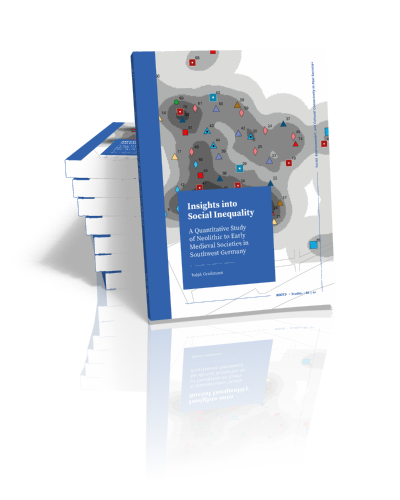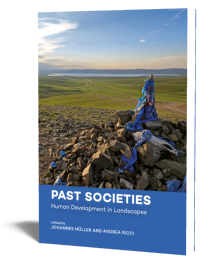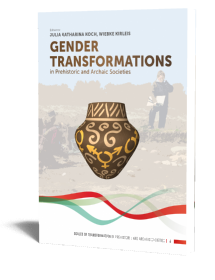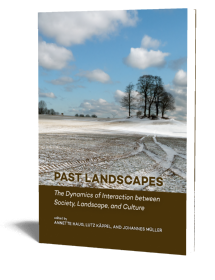Insights into Social Inequality
A Quantitative Study of Neolithic to Early Medieval Societies in Southwest Germany
Ralph Grossmann | 2021

Insights into Social Inequality
A Quantitative Study of Neolithic to Early Medieval Societies in Southwest Germany
Ralph Grossmann | 2021
Paperback ISBN: 9789088909771 | Hardback ISBN: 9789088909788 | Imprint: Sidestone Press Academics | Format: 210x280mm | 240 pp. | ROOTS Studies 01 | Series: ROOTS Studies | Language: English | 23 illus. (bw) | 122 illus. (fc) | Keywords: prehistory; protohistory, archaeology; social inequality; Southwest Germany; burial grounds; multivariate analyses; spatial analyses | download cover | DOI: 10.59641/9zd5722b
Read online or downloaded 966 times
-
Digital & Online access
This is a full Open Access publication, click below to buy in print, browse, or download for free.
-
Buy via Sidestone (EU & UK)
-
Buy via our Distributors (WORLD)
For non-EU or UK destinations you can buy our books via our international distributors. Although prices may vary this will ensure speedy delivery and reduction in shipping costs or import tax. But you can also order with us directly via the module above.
UK international distributor
USA international distributor
-
Bookinfo
Paperback ISBN: 9789088909771 | Hardback ISBN: 9789088909788 | Imprint: Sidestone Press Academics | Format: 210x280mm | 240 pp. | ROOTS Studies 01 | Series: ROOTS Studies | Language: English | 23 illus. (bw) | 122 illus. (fc) | Keywords: prehistory; protohistory, archaeology; social inequality; Southwest Germany; burial grounds; multivariate analyses; spatial analyses | download cover | DOI: 10.59641/9zd5722b
Read online or downloaded 966 times

We will plant a tree for each order containing a paperback or hardback book via OneTreePlanted.org.
Social inequality is a subject of contemporary concerns. Life capabilities and the access to resources vary significantly in rich and poor countries, between elites and others. Furthermore, inequalities based on bio-anthropological and non-bio-anthropological causes are almost universal. Accordingly, inequality was also inherent in past societies and archaeologists have continually examined and interpreted social inequalities in sources such as burial grounds.
This book continues such analyses with a new multi-proxy approach. It reveals social inequalities in selected past burial grounds from Southwestern Germany. The burial grounds date to the Early Neolithic (Schwetzingen), the Final Neolithic (Lauda-Königshofen), the Early Bronze Age (Singen), the Early Iron Age (Magdalenenbergle), and the Early Medieval period (Horb-Altheim). The challenge was to identify hierarchical and heterarchical differences and inequalities within the burial grounds based on a multitude of different proxies. The examination encompasses variations in the distribution of grave goods, burial pit sizes, as well as bio-anthropological and isotope data. Furthermore, spatial analyses of burial grounds and, in particular, on the distances between the graves play an essential role in this examination.
The results reveal social inequalities among and within genders and age cohorts that are differently pronounced in the respective cemeteries. Furthermore, the results of multi-proxy analyses lead to the interpretation that the sites differ concerning the respective degrees of inequality and power strategy modes. In detail, it can be observed that the Early Iron Age and the Early Bronze Age sites demonstrate a relatively high degree of inequality as compared to the other sites. More specifically, the investigation of sites from the Early Iron Age and the Final Neolithic rather reveal a network-based power strategy, whereas sites from the Early Neolithic, the Early Bronze Age and the Early Medieval period tend to show a corporate-based power strategy.
Preface of the author
Preface of the editors
1. Introduction
2. Theories of social inequality
3. Empirical approach to social inequality
4. Methods
4.1. Differences in values of grave goods and burial pit sizes
4.2. Bioanthropological data
4.3. Stable isotope analyses
4.4. Pathologies
4.5. Spatial analyses
4.6. Statistical procedure
5. Source critique
6. Schwetzingen (Early Neolithic)
6.1. Spatial analysis
6.2. Values of grave goods
6.3. Burial pit sizes
6.4. Values of grave goods and burial pit sizes
6.5. Lorenz curves and Gini indices
6.6. Distance to the next burial
6.7. Diet and status
6.8. Body height
6.9. Hierarchy, heterogeneity, transformation
6.10. Summary
7. Lauda-Königshofen (Late Neolithic)
7.1. Spatial analysis
7.2. Values of grave goods
7.3. Burial pit sizes
7.4. Values of grave goods and burial pit sizes
7.5. Lorenz curves and Gini indices
7.6. Distance to the next burial
7.7. Diet, growth and status: Nitrogen (δ15N)
7.8. Hierarchy, heterogeneity, transformation
7.9. Summary
8. Singen at Hohentwiel (Early Bronze Age)
8.1. Spatial analysis
8.2. Values of grave goods
8.3. Burial pit sizes
8.4. Values of grave goods and burial pit sizes
8.5. Lorenz curves and Gini indices
8.6. Distance to the next burial
8.7. Diet, growth and status: Nitrogen (δ15N)
8.8. Heterogeneity and transformation
8.9. Strontium isotope analysis
8.10. Summary
9. Magdalenenbergle, Villingen (Early Iron Age)
9.1. Spatial Analysis
9.2. Values of grave goods
9.3. Burial pit sizes
9.4. Values of grave goods and burial pit sizes
9.5. Lorenz curves and Gini indices
9.6. Distance to the central burial
9.7. Diet and social position: Nitrogen isotope analysis (δ15N)
9.8. Tooth decay
9.9. Strontium isotope analysis
9.10. Summary
10. Horb-Altheim (Early Medieval period)
10.1. Spatial analysis
10.2. Values of grave goods
10.3. Burial pit sizes
10.4. Lorenz curves and Gini indices
10.5. Values of grave goods and burial pit sizes
10.6. Distance to the next burial
10.7. Growth and body height
10.8. Pathologies
10.9. Heterogeneity and transformation
10.10. Summary
Synthesis
Conclusion
References
Dr. Ralph Grossmann
Ralph Grossmann is currently a Postdoctoral Fellow of the Excellence Cluster ROOTS at Kiel University and he is a member of the Subcluster Social Inequality. From March to August 2020, he held a position as a deputy scientific coordinator of the Excellence Cluster ROOTS. He was a member of the Graduate School ‘Human Development in Landscapes’ from 2010 to 2018 and obtained his doctoral degree in philosophy in 2016 at Kiel University with an analysis on Corded Ware and Bell Beaker burials in the German Rhine and Saale regions.
Abstract:
Social inequality is a subject of contemporary concerns. Life capabilities and the access to resources vary significantly in rich and poor countries, between elites and others. Furthermore, inequalities based on bio-anthropological and non-bio-anthropological causes are almost universal. Accordingly, inequality was also inherent in past societies and archaeologists have continually examined and interpreted social inequalities in sources such as burial grounds.
This book continues such analyses with a new multi-proxy approach. It reveals social inequalities in selected past burial grounds from Southwestern Germany. The burial grounds date to the Early Neolithic (Schwetzingen), the Final Neolithic (Lauda-Königshofen), the Early Bronze Age (Singen), the Early Iron Age (Magdalenenbergle), and the Early Medieval period (Horb-Altheim). The challenge was to identify hierarchical and heterarchical differences and inequalities within the burial grounds based on a multitude of different proxies. The examination encompasses variations in the distribution of grave goods, burial pit sizes, as well as bio-anthropological and isotope data. Furthermore, spatial analyses of burial grounds and, in particular, on the distances between the graves play an essential role in this examination.
The results reveal social inequalities among and within genders and age cohorts that are differently pronounced in the respective cemeteries. Furthermore, the results of multi-proxy analyses lead to the interpretation that the sites differ concerning the respective degrees of inequality and power strategy modes. In detail, it can be observed that the Early Iron Age and the Early Bronze Age sites demonstrate a relatively high degree of inequality as compared to the other sites. More specifically, the investigation of sites from the Early Iron Age and the Final Neolithic rather reveal a network-based power strategy, whereas sites from the Early Neolithic, the Early Bronze Age and the Early Medieval period tend to show a corporate-based power strategy.
Contents
Preface of the author
Preface of the editors
1. Introduction
2. Theories of social inequality
3. Empirical approach to social inequality
4. Methods
4.1. Differences in values of grave goods and burial pit sizes
4.2. Bioanthropological data
4.3. Stable isotope analyses
4.4. Pathologies
4.5. Spatial analyses
4.6. Statistical procedure
5. Source critique
6. Schwetzingen (Early Neolithic)
6.1. Spatial analysis
6.2. Values of grave goods
6.3. Burial pit sizes
6.4. Values of grave goods and burial pit sizes
6.5. Lorenz curves and Gini indices
6.6. Distance to the next burial
6.7. Diet and status
6.8. Body height
6.9. Hierarchy, heterogeneity, transformation
6.10. Summary
7. Lauda-Königshofen (Late Neolithic)
7.1. Spatial analysis
7.2. Values of grave goods
7.3. Burial pit sizes
7.4. Values of grave goods and burial pit sizes
7.5. Lorenz curves and Gini indices
7.6. Distance to the next burial
7.7. Diet, growth and status: Nitrogen (δ15N)
7.8. Hierarchy, heterogeneity, transformation
7.9. Summary
8. Singen at Hohentwiel (Early Bronze Age)
8.1. Spatial analysis
8.2. Values of grave goods
8.3. Burial pit sizes
8.4. Values of grave goods and burial pit sizes
8.5. Lorenz curves and Gini indices
8.6. Distance to the next burial
8.7. Diet, growth and status: Nitrogen (δ15N)
8.8. Heterogeneity and transformation
8.9. Strontium isotope analysis
8.10. Summary
9. Magdalenenbergle, Villingen (Early Iron Age)
9.1. Spatial Analysis
9.2. Values of grave goods
9.3. Burial pit sizes
9.4. Values of grave goods and burial pit sizes
9.5. Lorenz curves and Gini indices
9.6. Distance to the central burial
9.7. Diet and social position: Nitrogen isotope analysis (δ15N)
9.8. Tooth decay
9.9. Strontium isotope analysis
9.10. Summary
10. Horb-Altheim (Early Medieval period)
10.1. Spatial analysis
10.2. Values of grave goods
10.3. Burial pit sizes
10.4. Lorenz curves and Gini indices
10.5. Values of grave goods and burial pit sizes
10.6. Distance to the next burial
10.7. Growth and body height
10.8. Pathologies
10.9. Heterogeneity and transformation
10.10. Summary
Synthesis
Conclusion
References
Dr. Ralph Grossmann
Ralph Grossmann is currently a Postdoctoral Fellow of the Excellence Cluster ROOTS at Kiel University and he is a member of the Subcluster Social Inequality. From March to August 2020, he held a position as a deputy scientific coordinator of the Excellence Cluster ROOTS. He was a member of the Graduate School ‘Human Development in Landscapes’ from 2010 to 2018 and obtained his doctoral degree in philosophy in 2016 at Kiel University with an analysis on Corded Ware and Bell Beaker burials in the German Rhine and Saale regions.
-
Digital & Online access
This is a full Open Access publication, click below to buy in print, browse, or download for free.
-
Buy via Sidestone (EU & UK)
-
Buy via our Distributors (WORLD)
For non-EU or UK destinations you can buy our books via our international distributors. Although prices may vary this will ensure speedy delivery and reduction in shipping costs or import tax. But you can also order with us directly via the module above.
UK international distributor
USA international distributor
- Browse all books by subject
-
Search all books

We will plant a tree for each order containing a paperback or hardback book via OneTreePlanted.org.
You might also like:
© 2025 Sidestone Press KvK nr. 28114891 Privacy policy Sidestone Newsletter Terms and Conditions (Dutch)








